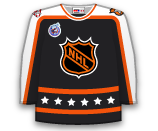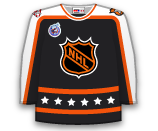Hoglander has just one assist in four games this season. He'll be a healthy scratch in Minnesota with Conor Garland expected to draw back into the lineup.

Hoglander has just one assist in four games this season. He'll be a healthy scratch in Minnesota with Conor Garland expected to draw back into the lineup.

Sanford suited up for two straight games but will be scratched in favour of Kiefer Sherwood on Thursday. Sanford has yet to record a point while playing just 8:54 ATOI in two games this season.

Sherwood was a healthy scratch for the last two games but he will replace Zach Sanford in the lineup on Thursday. Sherwood has one goal and one assist in three games this season.

Lauzon played in the last two games, but he will be replaced by Mark Borowiecki in the lineup in Columbus. Lauzon has a minus-1 rating and six PIMS in three games this season.

Benoit has been in and out of the Ducks lineup through the first four games. Thursday will mark the third time he's been scratched in five games. He'll be replaced by Nathan Beaulieu.

Beaulieu has been scratched for three straight games but will replace Simon Benoit in the lineup on Thursday. Beaulieu was a minus-1 in 13:06 TOI in his only game of the season.

Leason appeared in two straight games, going minus-2 in 11:40 ATOI. He'll be scratched Thursday with Pavol Regenda drawing back in.

Regenda was a healthy scratch in New Jersey on Tuesday but will replace Brett Leason in the lineup on Thursday. Regenda has two assists and three shots in three games this season.

Lauko will be a healthy scratch for the second time in three games, with Jack Studnicka drawing into the Bruins lineup to replace him.

Studnicka appeared in 15 games last season, picking up three assists and 21 shots. Studnicka will replace Jakub Lauko in the lineup and centre the third line with Trent Frederic and Charlie Coyle.

Stralman was eligible to play in Canada on Tuesday but will not be available for Thursday's game vs. the Ducks. Luckily for the Bruins, Matt Grzelcyk (shoulder) is set for his season debut to replace Stralman.

Malgin has scored one goal with just two shots while playing 11:18 ATOI in four games this season. He'll take a seat on Thursday with Nick Robertson making his season debut.

Robertson was the victim of a numbers game after a strong preseason showing but is back with the Maple Leafs and will make his season debut on Thursday. Robertson, who has one goal and one assist in 16 career NHL games, will replace Denis Malgin and skate on the second line with John Tavares and William Nylander.


The 15-year-veteran will join his seventh NHL team Tuesday when he takes the ice for Boston as they take on Ottawa Tuesday. He is only 70 games from reaching the 1000 games played club having collected 63 goals and 293 points in his 930 GP throughout his 15-year career.

The 28-year-old Centre will see his first action of 2022-23 as he takes the spot of Jack Quinn in the Sabres' lineup Tuesday. In his first season in Buffalo in 2021-22, Hinostroza scored 13 goals to go along with 25 points and 92 shots across 62 games.

Head coach Don Granato claimed "He won't be out long" in reference to 21-year-old Jack Quinn being left out of the lineup Tuesday. The 2020 No.8 overall pick has struggled to find ice time early on this season averaging 10:29 TOI through his first two games while putting up zero points.

The 24-year-old defenseman will get his first taste of NHL action this season after collecting one assist in the first 20 games of his career in 2021-22 with the Oilers. He will be brought in as a seventh defenceman for the Oilers' battle against Buffalo.

Ryan will take a seat as Markus Niemelainen draws into the Oilers' lineup Tuesday. Ryan has struggled in two games this season, collecting only one shot while averaging only 9:30 ATOI.

The seven-year veteran will hit the shelf after a one-game showing where he played only 12:12 TOI. He takes a seat as Nick Holden draws back into the lineup for the Senators.
